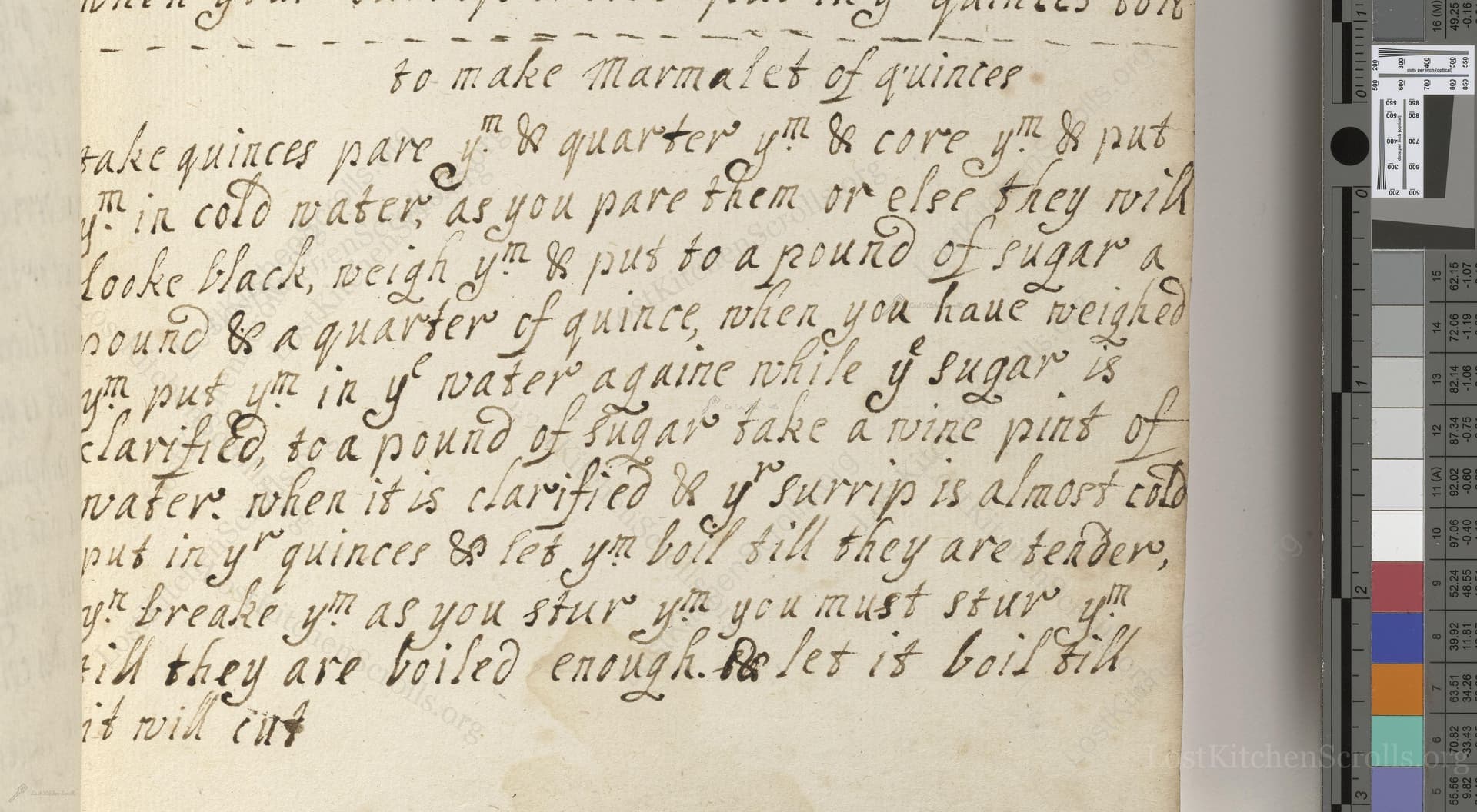To Make Marmalet Of Quinces
From the treasured pages of Culinary and medicinal recipe book of Mary Smith
Written by Mary Smith

To Make Marmalet Of Quinces
"take quinces pare y^{m} & quarter y^{m} & core y^{m} & put y^{m} in cold water as you pare them or else they will looke black, weigh y^{m} & put to a pound of sugar a pound & a quarter of quince, when you haue weighed y^{m} put y^{m} in y^{e} water againe while y^{r} sugar is clarified, to a pound of sugar take a wine pint of water, when it is clarified & y^{r} surrip is almost cold put in y^{r} quinces & let y^{m} boil till they are tender, y^{n} breake y^{m} as you stur y^{m} you must stur y^{m} till they are boiled enough. & let it boil till it will cut"
Note on the Original Text
Seventeenth-century recipes were written as conversational guidance, presuming experience in the kitchen and omitting quantities or times unless absolutely necessary. The quirky spellings—'y^m' (them), 'y^e' (the), and 'y^r' (your/their)—are examples of how letters and abbreviations were used for speed and space. No times or temperatures are given; cooks judged readiness by the look and feel of the marmalade, such as when 'it will cut.' The recipe gives steps in sequence but expects the cook to fill in the gaps with skill and intuition.

Title
Culinary and medicinal recipe book of Mary Smith (1662)
You can also click the book image above to peruse the original tome
Writer
Mary Smith
Era
1662
Publisher
Unknown
Background
A delightful window into 17th-century kitchens, this cookbook serves up recipes and culinary wisdom from a bygone era, inviting readers to savor the flavors and traditions of the past.
Kindly made available by
Folger Shakespeare Library
This recipe comes from the household book of Mary Smith, dating approximately to 1662. The mid-seventeenth century was a period of burgeoning domestic culinary practice, where preserving fruits was both a necessity and a sign of good household management. Marmalets (marmalades) were originally set fruit pastes rather than today's spreadable jams. Quince was highly prized for its heady perfume and natural pectin, making it ideal for such preserves. Recipes like this reflect both resourcefulness and the era's fondness for sweetmeats and confections at the table.

Back in the 1660s, this marmalade would have been made using a brass or copper preserving pan over an open hearth or on a charcoal stove. Sugar would be clarified with a ladle, and stirring done with sturdy wooden spoons or paddles. Weights and measures were managed with hand-held scales and jugs or tankards for liquid. Cooling and setting often took place in shallow wooden or ceramic dishes, sometimes with string used as a slicing guide once set.
Prep Time
30 mins
Cook Time
1 hr
Servings
10
We've done our best to adapt this historical recipe for modern kitchens, but some details may still need refinement. We warmly welcome feedback from fellow cooks and culinary historians — your insights support the entire community!
Ingredients
- 2.75 lb quinces (peeled, cored, and quartered)
- 2.2 lb granulated sugar
- 1 pint (20 fl oz) water (equivalent to one 17th-century wine pint)
- Cold water for soaking quinces
Instructions
- To make quince marmalade in the manner of seventeenth-century kitchens, begin by peeling and coring your quinces, working quickly and placing each piece in a bowl of cold water to prevent browning.
- Weigh your prepared quinces: for every 2.2 lb of sugar, use 2.75 lb quince.
- In a large pot, combine each 2.2 lb of sugar with 1 pint (20 fl oz) of water.
- Heat gently to dissolve the sugar, skimming off any impurities to clarify the syrup.
- Allow the syrup to cool slightly, then drain the quinces and add them to the pot.
- Bring the mixture gently to a boil and cook, stirring continuously, until the quinces are tender and can be broken up with a spoon.
- Continue stirring and boiling until the marmalade thickens enough to hold its shape and can be cut when set.
- Pour into molds or jars and let cool to set.
Estimated Calories
210 per serving
Cooking Estimates
It takes about 30 minutes to prepare the quinces and ingredients before you start cooking. The cooking process itself usually takes 1 hour. This recipe makes about 10 servings, each with around 210 calories.
As noted above, we have made our best effort to translate and adapt this historical recipe for modern kitchens, taking into account ingredients nowadays, cooking techniques, measurements, and so on. However, historical recipes often contain assumptions that require interpretation.
We'd love for anyone to help improve these adaptations. Community contributions are highly welcome. If you have suggestions, corrections, or cooking tips based on your experience with this recipe, please share them below.
Join the Discussion
Rate This Recipe
Dietary Preference
Main Ingredients
Culinary Technique

Den Bockfisch In Einer Fleisch Suppen Zu Kochen
This recipe hails from a German manuscript cookbook compiled in 1696, a time whe...

Die Grieß Nudlen Zumachen
This recipe comes from a rather mysterious manuscript cookbook, penned anonymous...

Ein Boudain
This recipe comes from an anonymous German-language manuscript cookbook from 169...

Ein Gesaltzen Citroni
This recipe, dating from 1696, comes from an extensive anonymous German cookbook...
Browse our complete collection of time-honored recipes



